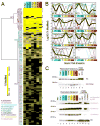Dynamic and Combinatorial Landscape of Histone Modifications during the Intraerythrocytic Developmental Cycle of the Malaria Parasite
- PMID: 27291344
- PMCID: PMC5905347
- DOI: 10.1021/acs.jproteome.6b00366
Dynamic and Combinatorial Landscape of Histone Modifications during the Intraerythrocytic Developmental Cycle of the Malaria Parasite
Abstract
A major obstacle in understanding the complex biology of the malaria parasite remains to discover how gene transcription is controlled during its life cycle. Accumulating evidence indicates that the parasite's epigenetic state plays a fundamental role in gene expression and virulence. Using a comprehensive and quantitative mass spectrometry approach, we determined the global and dynamic abundance of histones and their covalent post-transcriptional modifications throughout the intraerythrocytic developmental cycle of Plasmodium falciparum. We detected a total of 232 distinct modifications, of which 160 had never been detected in Plasmodium and 88 had never been identified in any other species. We further validated over 10% of the detected modifications and their expression patterns by multiple reaction monitoring assays. In addition, we uncovered an unusual chromatin organization with parasite-specific histone modifications and combinatorial dynamics that may be directly related to transcriptional activity, DNA replication, and cell cycle progression. Overall, our data suggest that the malaria parasite has a unique histone modification signature that correlates with parasite virulence.
Keywords: cell cycle; epigenetics; histones; label-free quantification; malaria; multiple reaction monitoring; parasite; post-translational modifications; tandem mass spectrometry.
Figures




Similar articles
-
Histone 4 lysine 8 acetylation regulates proliferation and host-pathogen interaction in Plasmodium falciparum.Epigenetics Chromatin. 2017 Aug 22;10(1):40. doi: 10.1186/s13072-017-0147-z. Epigenetics Chromatin. 2017. PMID: 28830512 Free PMC article.
-
Malaria: could its unusual epigenome be the weak spot?Int J Biochem Cell Biol. 2010 Jun;42(6):781-4. doi: 10.1016/j.biocel.2010.03.010. Epub 2010 Mar 18. Int J Biochem Cell Biol. 2010. PMID: 20303414 Review.
-
Predicting gene expression in the human malaria parasite Plasmodium falciparum using histone modification, nucleosome positioning, and 3D localization features.PLoS Comput Biol. 2019 Sep 11;15(9):e1007329. doi: 10.1371/journal.pcbi.1007329. eCollection 2019 Sep. PLoS Comput Biol. 2019. PMID: 31509524 Free PMC article.
-
Dynamic epigenetic regulation of gene expression during the life cycle of malaria parasite Plasmodium falciparum.PLoS Pathog. 2013 Feb;9(2):e1003170. doi: 10.1371/journal.ppat.1003170. Epub 2013 Feb 28. PLoS Pathog. 2013. PMID: 23468622 Free PMC article.
-
Chromatin-mediated epigenetic regulation in the malaria parasite Plasmodium falciparum.Eukaryot Cell. 2010 Aug;9(8):1138-49. doi: 10.1128/EC.00036-10. Epub 2010 May 7. Eukaryot Cell. 2010. PMID: 20453074 Free PMC article. Review.
Cited by
-
"Reading" a new chapter in protozoan parasite transcriptional regulation.PLoS Pathog. 2021 Dec 2;17(12):e1010056. doi: 10.1371/journal.ppat.1010056. eCollection 2021 Dec. PLoS Pathog. 2021. PMID: 34855919 Free PMC article. Review.
-
Onametostat, a PfPRMT5 inhibitor, exhibits antimalarial activity to Plasmodium falciparum.Antimicrob Agents Chemother. 2024 Oct 8;68(10):e0017624. doi: 10.1128/aac.00176-24. Epub 2024 Aug 28. Antimicrob Agents Chemother. 2024. PMID: 39194263 Free PMC article.
-
Epigenetic Regulation and Chromatin Remodeling in Malaria Parasites.Annu Rev Microbiol. 2023 Sep 15;77:255-276. doi: 10.1146/annurev-micro-032521-041554. Epub 2023 Jun 2. Annu Rev Microbiol. 2023. PMID: 37268002 Free PMC article. Review.
-
Histone 4 lysine 8 acetylation regulates proliferation and host-pathogen interaction in Plasmodium falciparum.Epigenetics Chromatin. 2017 Aug 22;10(1):40. doi: 10.1186/s13072-017-0147-z. Epigenetics Chromatin. 2017. PMID: 28830512 Free PMC article.
-
The role of long noncoding RNAs in malaria parasites.Trends Parasitol. 2023 Jul;39(7):517-531. doi: 10.1016/j.pt.2023.03.016. Epub 2023 Apr 29. Trends Parasitol. 2023. PMID: 37121862 Free PMC article. Review.
References
-
- Martin C, Zhang Y. Mechanisms of epigenetic inheritance. Curr Opin Cell Biol. 2007;19(3):266–72. - PubMed
-
- Tan M, Luo H, Lee S, Jin F, Yang JS, Montellier E, Buchou T, Cheng Z, Rousseaux S, Rajagopal N, Lu Z, Ye Z, Zhu Q, Wysocka J, Ye Y, Khochbin S, Ren B, Zhao Y. Identification of 67 histone marks and histone lysine crotonylation as a new type of histone modification. Cell. 2011;146(6):1016–28. - PMC - PubMed
-
- Rivera C, Gurard-Levin ZA, Almouzni G, Loyola A. Histone lysine methylation and chromatin replication. Biochim Biophys Acta. 2014;1839(12):1433–9. - PubMed
Publication types
MeSH terms
Substances
Grants and funding
LinkOut - more resources
Full Text Sources
Other Literature Sources
Medical

